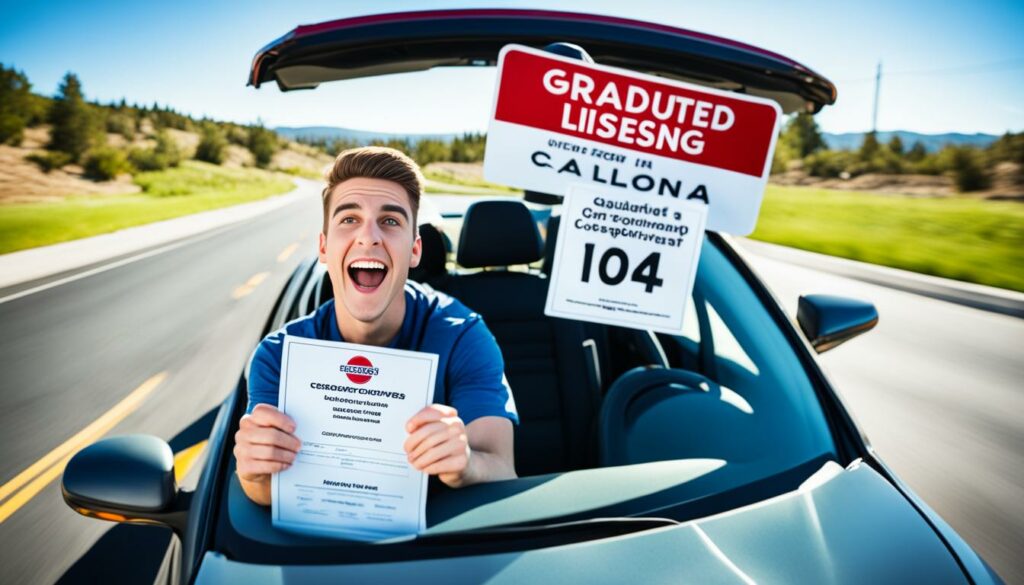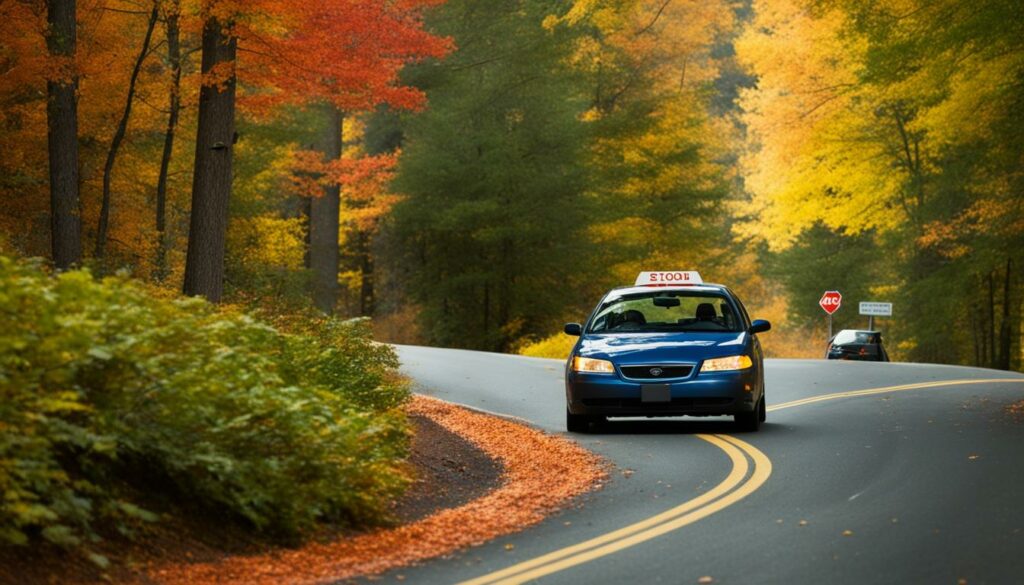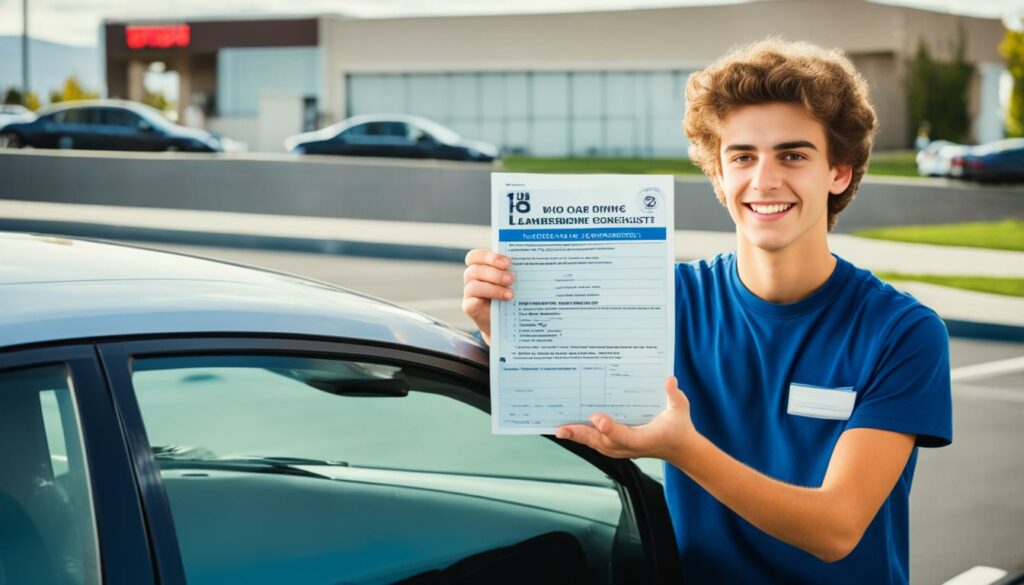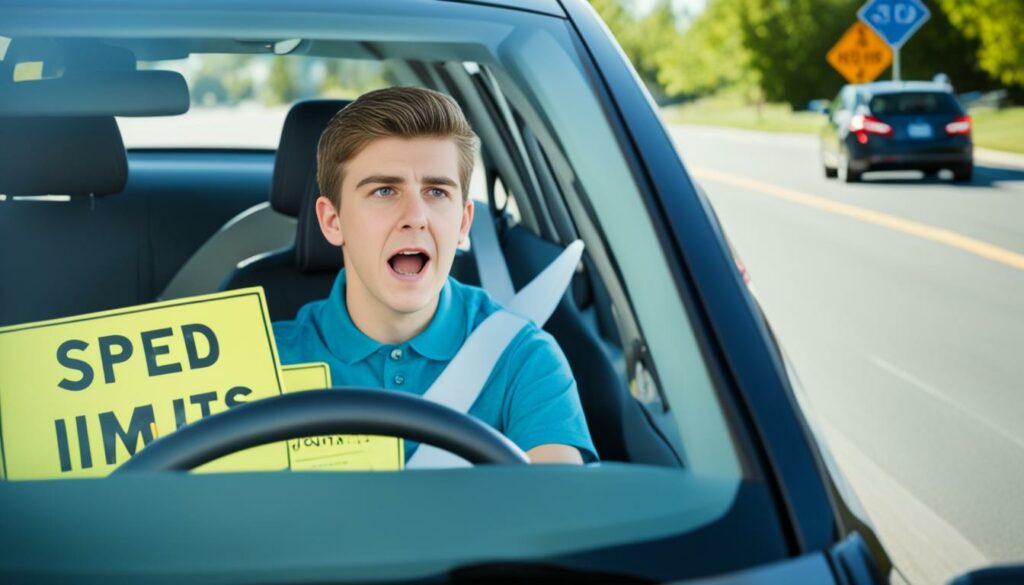Can a 16-Year-Old Drive Alone? Know the Rules
Are you a parent or a teenager wondering about the driving laws for 16-year-olds? It’s essential to understand the underage driving regulations to ensure the safety of young drivers on the road.
Key Takeaways
- Vehicle crashes are the leading cause of death among 16- to 24-year-olds.
- Pennsylvania’s Graduated Driver Licensing Law sets restrictions and requirements for young drivers.
- Young drivers must go through a learner’s permit phase, a junior license phase, and finally, an unrestricted license phase.
- National Teen Driver Safety Week is observed annually to raise awareness about the elevated crash risk for teenagers.
- Parents and guardians play a crucial role in teaching teenagers to drive and ensuring safe driving education.
Pennsylvania’s Graduated Driver Licensing Law

Pennsylvania’s Graduated Driver Licensing Law, implemented in 1999 and updated in 2011, aims to enhance teen driver safety by implementing a structured process for young drivers to obtain their driver’s license. This law incorporates three distinct phases: the learner’s permit phase, the junior license phase, and the unrestricted license phase.
During the learner’s permit phase, young drivers must complete a minimum of six months of learning and accumulate at least 65 hours of adult-supervised skill-building. This phase allows novice drivers to gain valuable experience and knowledge under the guidance of a responsible adult.
To further ensure the safety of teen drivers, Pennsylvania’s Graduated Driver Licensing Law imposes several restrictions. Firstly, it restricts nighttime driving for young drivers, prohibiting them from operating a vehicle between the hours of 11 p.m. and 5 a.m., unless accompanied by a parent or guardian. This restriction helps reduce the risk of accidents that are more prevalent during nighttime hours.
In addition, the law limits the number of passengers that teen drivers can have in their vehicle. Initially, young drivers may only transport one passenger who is not a family member. After six months, this restriction increases to a maximum of three passengers who are under 18, excluding immediate family members.
Furthermore, Pennsylvania’s Graduated Driver Licensing Law imposes sanctions for high-risk driving behaviors. If a young driver receives a traffic citation or is found to be at fault in a crash, they may face penalties such as an extended period of the learner’s permit phase or the junior license phase, or even license suspension.
This law plays a crucial role in ensuring the safety of teenage drivers on Pennsylvania’s roads. By providing a structured learning process, implementing driving restrictions, and imposing consequences for high-risk behaviors, Pennsylvania’s Graduated Driver Licensing Law aims to reduce the number of accidents involving teen drivers and promote responsible driving habits.
Through the implementation of Pennsylvania’s Graduated Driver Licensing Law, the state acknowledges the increased crash risk among teenagers and takes proactive measures to minimize these risks. By properly educating and guiding young drivers, Pennsylvania aims to create a safer driving environment for all road users.
National Teen Driver Safety Week

Every year, during the third week of October, National Teen Driver Safety Week is observed to raise awareness about the elevated crash risk faced by teenagers. This initiative aims to address the alarming statistics that reveal vehicle crashes as the leading cause of death among 16-24-year-olds. Teenagers are particularly vulnerable on the road due to their limited driving experience and increased exposure to various distractions.
During this week, various educational programs and events are organized to promote safe driving habits and emphasize the importance of responsible behavior behind the wheel. The campaign seeks to engage teenagers, their parents, educators, and the community at large in efforts to reduce the number of teen car accidents, injuries, and fatalities.
This image highlights the importance of Teen Driver Safety Week and the need to prioritize the safety of young drivers.
By focusing on this critical issue and spreading awareness, Teen Driver Safety Week plays a crucial role in equipping teenagers with the necessary knowledge, skills, and attitudes to navigate the road safely. It aims to educate them about the risks associated with reckless driving behaviors, such as speeding, distracted driving, impaired driving, and not wearing seat belts. The week-long campaign encourages teenagers to make responsible choices behind the wheel and serves as a reminder for parents and guardians to actively participate in their teenager’s driving education.
| Key Goals of National Teen Driver Safety Week | |
|---|---|
| 1. | Spreading awareness about the elevated crash risk faced by teenagers |
| 2. | Encouraging safe and responsible driving practices among teenagers |
| 3. | Highlighting the role of parents and guardians in shaping teen drivers’ behavior |
| 4. | Emphasizing the importance of seat belt usage and other safety measures |
| 5. | Reducing the number of teen car accidents, injuries, and fatalities |
Parents, educators, and the community can actively participate in Teen Driver Safety Week by organizing educational events, sharing resources, and encouraging open discussions about safe driving habits. By working together, we can create a safer environment for teenage drivers and potentially save lives.
Learner’s Permit Requirements

To obtain a learner’s permit in Pennsylvania, young drivers must fulfill specific requirements and pass certain examinations:
- Physical Examination
- Vision Screening
- Knowledge Test
Once these initial requirements are met, aspiring drivers are required to complete a period of six months of learning, under the supervision of an adult who is at least 21 years old. During this time, learners must accumulate a minimum of 65 hours of adult-supervised skill building, including:
- 10 hours of night driving
- 5 hours of driving in poor weather conditions
This extensive period of supervised learning and skill building prepares young drivers for the challenges they will face on the road and ensures that they have acquired the necessary knowledge and experience to become competent and responsible drivers.
Starting the journey towards a driver’s license
“It’s crucial for young drivers to develop their skills under the guidance of a responsible adult. The learner’s permit phase provides invaluable opportunities for learners to gain hands-on experience in various driving scenarios, preparing them for the responsibilities that come with a driver’s license.”
During the learner’s permit phase, it is essential for learners to follow the guidance of their supervising adult and adhere to the traffic laws and regulations. This phase serves as a foundation for developing safe driving habits and bolstering confidence behind the wheel.
Junior License Restrictions

Once young drivers complete the learner’s permit phase, they can obtain a junior license. However, there are still certain restrictions in place to ensure their safety and the safety of others on the road.
One of the primary restrictions for junior license holders is the nighttime driving restriction. From 11 p.m. to 5 a.m., these drivers are not allowed to drive unless accompanied by a supervising adult. This restriction is in place to minimize the risks associated with nighttime driving for inexperienced drivers.
Another restriction is the passenger limitation. Junior license holders are only permitted to have one non-family member under 18 as a passenger. After six months, this restriction increases to a maximum of three passengers under 18. Immediate family members, however, are exempt from this restriction.
These restrictions aim to gradually increase young drivers’ experience and reduce the potential distractions and hazards that can arise from nighttime driving and excessive passenger loads.
| Junior License Restrictions | Details |
|---|---|
| Nighttime Driving Restriction | Between 11 p.m. and 5 a.m., junior license holders cannot drive unless accompanied by a supervising adult. |
| Passenger Limitation | Junior license holders can have only one non-family member under 18 as a passenger, which increases to a maximum of three passengers under 18 after six months. |
It’s important for young drivers with junior licenses to adhere to these restrictions to ensure their safety and comply with the law. By following these guidelines, junior license holders can continue to gain valuable driving experience while minimizing potential risks on the road.
Unrestricted License

Once teen drivers reach a certain age and meet the requirements of the graduated system, they can obtain an unrestricted license, which provides full driving privileges. This is an exciting milestone that allows young drivers to enjoy the freedom of the open road without the previous restrictions. With an unrestricted license, teens can drive alone, travel long distances, and transport friends and family without limitations.
Obtaining an unrestricted license signifies that teen drivers have demonstrated the necessary skills and responsibility to navigate the roads safely and independently. It’s a testament to their commitment to learning and following the rules of the road throughout the learner’s permit and junior license phases.
In addition to fulfilling the required age and experience criteria, some young drivers may qualify for an early license before reaching the age of 18. This early license allows teens to obtain an unrestricted license sooner, provided they maintain a crash- and conviction-free record for 12 consecutive months. To further qualify for an early license, completion of an approved driver’s education course may also be required.
Receiving an unrestricted license is an important milestone in a teen’s journey toward independence and adulthood. It solidifies their driving privileges and opens up new opportunities for personal and professional growth. However, it’s crucial for young drivers to continue practicing safe driving habits and adhering to traffic laws, even with the newfound freedom an unrestricted license provides.
Having an unrestricted license is a privilege that comes with great responsibility. Teen drivers should always prioritize safety on the road, obeying speed limits, avoiding distractions, and practicing defensive driving techniques. By maintaining a commitment to safe driving practices, new drivers can enjoy the benefits and freedoms that come with an unrestricted license while keeping themselves and others safe.
Tips for Teens
As a teenager, practicing safe driving habits is essential to protect yourself and others on the road. By adopting these tips, you can reduce the risk of accidents and ensure a safer driving experience.
1. Wear Seat Belts
Always buckle up before starting your trip. Seat belts are a crucial safety measure that can significantly reduce the risk of injury or fatality in the event of a collision.
2. Avoid Drinking and Driving
Never get behind the wheel after consuming alcohol or drugs. Impaired driving is not only illegal but also extremely dangerous. Instead, assign a designated driver or use public transportation or ride-sharing services.
3. Refrain from Using Cellphones While Driving
Distracted driving is a leading cause of accidents among teenagers. Keep your phone out of reach and focus on the road. If necessary, pull over to a safe location to make or receive calls.
4. Obey Speed Limits
Follow the posted speed limits at all times. Speeding significantly increases the chances of an accident and reduces your ability to react to unexpected situations on the road.
5. Avoid Eating or Drinking
While it may be tempting to eat or drink while driving, it can distract you from the task at hand. Finish your meals or snacks before hitting the road or pull over to a safe location if necessary.
6. Adjust Controls Before Starting the Trip
Make any necessary adjustments to your seat, mirrors, climate controls, and audio system before you start driving. Trying to make these adjustments while on the road can divert your attention and increase the risk of an accident.
7. Plan Ahead and Expect the Unexpected
Before you start your journey, plan your route and anticipate any challenges that may arise. Leave early to avoid rushing and be prepared for unexpected road conditions or delays. This will help you stay calm and focused on the road.
Remember, safe driving habits are not only important for your own well-being but also for the safety of others. By following these tips, you can become a responsible and confident driver.
| Safe Driving Tips for Teens | Benefits |
|---|---|
| Wear seat belts | Reduces the risk of severe injuries or death in accidents |
| Avoid drinking and driving | Prevents accidents and potential legal consequences |
| Refrain from using cellphones while driving | Reduces distractions and increases focus on the road |
| Obey speed limits | Keeps you and others safe by controlling your speed |
| Avoid eating or drinking while driving | Decreases the chances of distracted driving |
| Adjust controls before starting the trip | Ensures your full attention on driving, enhancing safety |
| Plan ahead and expect the unexpected | Allows for preparedness and reduces stress while driving |
Tips for Parents/Guardians
Parents and guardians play a crucial role in teaching teenagers to drive. By providing guidance, support, and education, they can help ensure their teens become safe and responsible drivers. Here are some tips to help parents fulfill their role in teaching teen driving:
- Set an Example: Parents should always model good driving behavior and follow traffic laws themselves. By demonstrating safe and responsible driving habits, parents can positively influence their teen’s driving behavior.
- Start Talking Early: It’s important to start discussing driving and road safety with your teenager before they turn 16. This gives them time to understand the rules of the road and develop a responsible attitude towards driving.
- Know the Rules of the Road: Parents should familiarize themselves with the driving laws in their state. Understanding the specific requirements and restrictions for teen drivers will help parents provide accurate and reliable information to their teens.
- Ensure the Vehicle is Safe: Before allowing your teenager to practice driving, make sure the vehicle they will be using is safe and well-maintained. Regularly check the tires, brakes, lights, and other essential components to minimize the risk of mechanical failures.
- Familiarize Yourself with Teaching Tasks: Teaching someone to drive requires specific tasks and responsibilities. Parents should familiarize themselves with the process of teaching driving, including administering practice sessions, providing feedback, and assessing progress.
- Encourage Practice in All Driving Situations: It’s essential to expose your teenager to a variety of driving situations, including different road types, weather conditions, and traffic patterns. This will help them develop the necessary skills and confidence to handle diverse driving scenarios.
- Emphasize Safe and Responsible Driving: Instill in your teenager the importance of driving safely and responsibly. Discuss the risks of aggressive driving, distracted driving, and intoxicated driving. Encourage them to always wear seat belts, avoid distractions, and obey traffic laws.
By following these tips, parents can effectively contribute to their teen’s safe driving education and help them become responsible and confident drivers.
Parent-Teen Driving Agreement
| Guidelines | Responsibilities | Consequences |
|---|---|---|
| No cell phone use while driving | Parent: Set a good example and refrain from phone use Teen: Keep phone out of reach and ignore distractions |
Loss of driving privileges for a specified period |
| No speeding or aggressive driving | Parent: Monitor teen’s speed and provide guidance Teen: Obey speed limits and drive responsibly |
Temporary suspension of driving privileges |
| No alcohol or drug use while driving | Parent: Discuss the dangers of impaired driving Teen: Never consume alcohol or drugs before driving |
Immediate loss of driving privileges, mandatory counseling |
| No driving past curfew | Parent: Enforce curfew and monitor teen’s whereabouts Teen: Respect curfew and inform parents of any changes |
Gradual extension of curfew restriction |
Creating a parent-teen driving agreement can further reinforce safe driving habits and set clear expectations for both parties. This agreement can include guidelines, responsibilities, and consequences for certain driving behaviors.
After Your Teenager Receives His or Her Driver’s License
Once your teenager has received their driver’s license, it’s important to establish clear guidelines and expectations to ensure their safety and responsible behavior on the road. Here are some key steps you can take:
1. Parent-Teen Driving Contract
Creating a parent-teen driving contract can help outline the rules and consequences for your teen driver. It establishes expectations regarding safe driving practices, such as obeying traffic laws, wearing seat belts, and avoiding distractions like cellphones. It also clarifies your role as a parent or guardian in supporting their learning process.
2. Set Passenger Limitations
Limiting the number of passengers your teenager can have in the car is an effective way to reduce distractions and minimize the risk of accidents. Research shows that the presence of peers in the vehicle can increase the likelihood of reckless driving behavior. Consider enforcing a restriction on the number of non-family passengers your teen can transport, especially during the initial months of their driving experience.
3. Enforce a Curfew
Setting a curfew for your teenager’s driving privileges helps ensure they are not on the road during high-risk hours. Nighttime driving can be more challenging due to reduced visibility and increased fatigue. By establishing a curfew, you can mitigate these risks and provide a structured framework for your teen’s driving activities.
4. Gradually Increase Driving Privileges
Granting full driving privileges all at once may overwhelm new teen drivers. Instead, consider gradually increasing their driving privileges over time. This can include allowing them to drive to specific destinations, gradually extending their driving distance, and giving them experience in different driving conditions. Gradual progression provides an opportunity for your teen to gain confidence and develop critical driving skills.
5. Prohibit Eating or Drinking While Driving
Eating or drinking while driving can divert your teenager’s attention from the road, significantly increasing the risk of accidents. Establish a clear rule that prohibits consuming food or beverages while driving to ensure their full focus remains on the task at hand – driving safely.
6. Monitor Your Teenager’s Driving Skills
Occasionally riding along with your teen driver allows you to assess their skills, observe their adherence to road rules, and offer guidance for improvement. This active involvement reinforces the importance of safe driving and provides an opportunity for ongoing coaching and support.
7. Enforce Observance of Speed Limits and Other Rules of the Road
Emphasize the importance of following speed limits and other rules of the road. Reiterate that responsible driving requires obeying traffic laws and respecting the safety of themselves and others. Reinforce these principles through regular conversations and reminders.
8. Educate Teens about the Dangers of Drinking and Driving
It is crucial to educate your teenager about the dangers and consequences of drinking and driving. Reinforce the importance of never getting behind the wheel after consuming alcohol and the potential legal and personal ramifications. Encourage open and honest communication about alcohol and its effects, establishing a foundation of trust and responsibility.
By implementing these measures, you can help guide your teenager to become a responsible and safe driver. Remember, your guidance and support play a vital role in shaping their driving habits and promoting a lifetime of safe and responsible driving.
Parent-Teen Contracts
Parent-teen driving contracts are important tools in establishing guidelines and expectations for teen drivers. These contracts play a crucial role in promoting safety on the road by setting clear rules and consequences for the teen driver. Additionally, they outline the parents’ responsibilities in helping the teen driver learn safe and responsible driving practices.
By implementing a parent-teen driving contract, parents can ensure that their teen understands the importance of following the law and adhering to safety guidelines. This contract can cover various aspects of driving, such as speed limits, seat belt usage, passenger limitations, and alcohol/drug use. It can also address the consequences of breaking these rules, which may include the loss of driving privileges or additional restrictions.
Many insurance companies provide sample parent-teen driving contracts that parents can use as a starting point. These sample contracts often include comprehensive safety guidelines and can be customized to suit individual needs and preferences. Additionally, organizations like AAA offer valuable resources and guidance on creating effective parent-teen driving contracts.
By establishing a parent-teen driving contract, parents can help instill responsible driving habits in their teenagers and reinforce the importance of complying with the teen driving laws. This proactive approach not only promotes safety but also enhances communication and trust between parents and teens, ultimately leading to a safer driving experience for everyone involved.
State-by-State Licensing Requirements
When it comes to obtaining driver’s licenses, the requirements can vary from state to state in the United States. Each state has its own set of regulations and guidelines for teen drivers. Most states follow a Graduated Driver Licensing (GDL) program that is designed to gradually introduce young drivers to the road and ensure their safety.
The GDL program sets restrictions and requirements for teen drivers, such as learner’s permits, supervised driving hours, and various stages of licensing. These requirements aim to provide new drivers with the necessary skills and experience to navigate the roads safely.
To give you a better understanding of the variation in licensing requirements across the country, here is an overview of some key elements found in different states:
- Age Requirements: The minimum age for obtaining a learner’s permit can vary from as young as 14 to as old as 16, depending on the state.
- Learner’s Permit Phase: The duration of the learner’s permit phase can range from a minimum of a few months up to a year or more.
- Supervised Driving: States often require a specific number of supervised driving hours, typically ranging from 30 to 65 hours, with a minimum number of daytime and nighttime hours.
- Driving Tests: Most states have a written knowledge test, a road skills test, or both, which must be passed to progress to the next licensing stage.
- Junior License: Some states have an intermediate licensing stage between a learner’s permit and an unrestricted license. This phase usually comes with restrictions, such as nighttime driving restrictions and limits on the number of passengers.
- Unrestricted License: The age at which a young driver can obtain an unrestricted license varies by state, typically ranging from 16 to 18 years old.
Example State-by-State Licensing Requirements:
| State | Minimum Age for Learner’s Permit | Supervised Driving Hours | Written Test | Road Skills Test | Nighttime Driving Restrictions |
|---|---|---|---|---|---|
| New York | 16 | 50 hours (15 at night) | Yes | Yes | 9 p.m. to 5 a.m. |
| California | 15 ½ | 50 hours (10 at night) | Yes | Yes | 11 p.m. to 5 a.m. (first year) |
| Texas | 15 | 30 hours (10 at night) | Yes | Yes | Midnight to 5 a.m. (first year) |
These are just a few examples, and it’s essential for both teens and parents to familiarize themselves with the specific licensing requirements in their state. The Department of Motor Vehicles (DMV) website or a local DMV office can provide detailed information about the regulations applicable to your location.
Understanding the state-by-state licensing requirements is crucial for teenagers and parents alike. By knowing and adhering to these regulations, young drivers can navigate the road safely and confidently.
Conclusion
Ensuring teen driver safety is of utmost importance, considering that vehicle crashes are one of the leading causes of death among teenagers. To address this concern, graduated driver licensing programs have been implemented to enhance the safety of young drivers. By gradually increasing driving privileges and imposing restrictions, these programs aim to provide teenagers with the necessary skills and experience to become responsible drivers.
However, the role of parents and their active involvement in promoting safe driving practices cannot be overstated. By setting a good example, educating their teens about the rules of the road, and emphasizing the importance of responsible driving, parents can significantly contribute to their teenager’s safety on the road.
Ultimately, it is crucial to recognize that teen driver safety is a shared responsibility. By working together, government agencies, parents, and teenagers themselves can create a safe driving environment, adhering to driving laws for teenagers and underage driving restrictions. By instilling safe driving habits and providing the necessary guidance, we can pave the way for a future where teen driver safety is no longer a concern.
FAQ
Can a 16-year-old drive alone?
No, 16-year-olds are generally required to be accompanied by a supervising adult when driving.
What are the driving laws for 16-year-olds?
The driving laws for 16-year-olds vary by state. However, most states have a Graduated Driver Licensing program, which sets restrictions and requirements for teen drivers.
What are the underage driving regulations?
Underage driving regulations typically include obtaining a learner’s permit, completing a certain number of practice hours, and adhering to restrictions such as nighttime driving and passenger limitations.
What is Pennsylvania’s Graduated Driver Licensing Law?
Pennsylvania’s Graduated Driver Licensing Law is a program designed to enhance teen driver safety. It includes a learner’s permit phase, a junior license phase, and finally, an unrestricted license phase.
What are the teen driver laws in Pennsylvania?
In Pennsylvania, teen drivers must complete six months of learning, 65 hours of adult-supervised skill building, and adhere to restrictions such as nighttime driving limits and passenger limitations.
What is Teen Driver Safety Week?
Teen Driver Safety Week is recognized annually during the third week of October. It aims to raise awareness about the elevated crash risk for teenagers and promote safe driving habits.
What is the leading cause of death among 16-24-year-olds?
Vehicle crashes are the leading cause of death among 16-24-year-olds.
What are the requirements for obtaining a learner’s permit?
In Pennsylvania, young drivers must pass a physical examination, vision screening, and knowledge test to obtain a learner’s permit. They must also complete six months of learning, be accompanied by a supervising adult, and have at least 65 hours of adult-supervised skill building.
What are the restrictions on a junior license?
Junior license holders in Pennsylvania have a nighttime driving restriction, limits on the number of passengers, and other high-risk driving behavior sanctions.
What is an unrestricted license?
An unrestricted license provides full driving privileges to teen drivers who have reached a certain age and met the requirements of the graduated system. This means they are no longer subject to restrictions and limitations.
What are some safe driving tips for teenagers?
Teenagers should always wear seat belts, avoid drinking and driving, refrain from using cellphones while driving, obey speed limits, and avoid eating or drinking while driving. It is also important to plan ahead, leave early, and expect the unexpected while on the road.
What role do parents/guardians play in teaching teenagers to drive?
Parents and guardians play a crucial role in teaching teenagers to drive. They should set an example, start talking about driving before the age of 16, ensure the vehicle is safe, and be familiar with the tasks and requirements of teaching driving. They should also encourage practice in all driving situations and emphasize the importance of safe and responsible driving.
What should parents do after their teenager receives their driver’s license?
After a teenager receives their driver’s license, parents should establish a parent-teen driving contract, set passenger limitations, enforce a curfew, gradually increase driving privileges, and monitor their teenager’s driving skills. Parents should also enforce observance of speed limits and other rules of the road, as well as educate teens about the dangers of drinking and driving.
What are parent-teen driving contracts?
Parent-teen driving contracts are important tools in establishing guidelines and expectations for teen drivers. These contracts set rules and consequences for the teen driver and outline the parents’ responsibilities in helping the teen driver learn safe and responsible driving.
What are the state-by-state licensing requirements for teen drivers?
Each state in the United States has its own licensing requirements for teen drivers. Most states follow a Graduated Driver Licensing program, which sets restrictions and requirements for teen drivers. The licensing requirements vary by state, and it’s important for teens and parents to understand the specific regulations in their state.
Why is teen driver safety a concern?
Teen driver safety is a crucial concern because vehicle crashes are the leading cause of death among teenagers. Graduated driver licensing programs aim to enhance teen driver safety by gradually increasing driving privileges and imposing restrictions on young drivers. Parents’ involvement and adherence to safe driving practices are essential in keeping teen drivers safe on the road.






